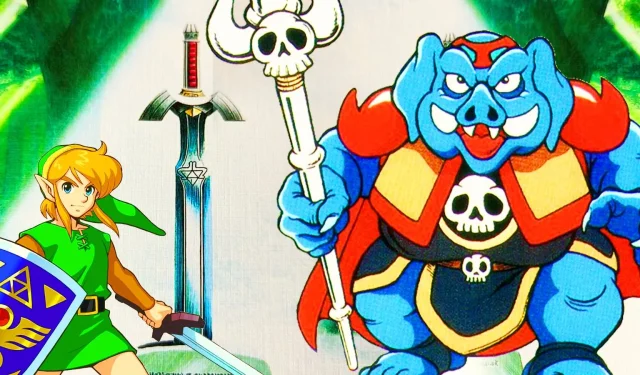
The Legend of Zelda: A Link to the Past is a beloved title among gamers, yet its significant influence on the franchise often goes unappreciated. Just as a contemporary audience might dismiss John Carpenter’s Halloween as a cliché, modern players might overlook the groundbreaking features of A Link to the Past, failing to recognize it as the origin of many beloved Zelda conventions.
As someone whose first experience with the franchise was through A Link to the Past, I, too, was initially unaware of its profound impact. When I encountered elements in later installments like Ocarina of Time, I presumed they had always been fundamental to the series. However, a closer examination reveals that many iconic traits were first introduced in A Link to the Past, transforming the way we think about the evolution of this renowned franchise.
The Introduction of Link’s Legendary Weapon
The Master Sword: Its Debut

Amongst the myriad of weapons wielded by Link, the Master Sword stands out as a defining artifact of the series. I was astonished to discover that this legendary blade made its first appearance in A Link to the Past, shaping its lore and aesthetics significantly.
This game not only introduced the Master Sword’s iconic design, featuring its distinctive curved purple hilt and the Triforce emblem on the blade, but it also established the conditions under which it could be obtained. Players must collect three spiritual stones—known as the Pendants of Virtue in this title—to prove their worthiness. This mechanic has been echoed in subsequent games, including Ocarina of Time and Wind Waker, though with different items.
At the conclusion of A Link to the Past, players are misled with the assertion that the Master Sword “sleeps again… forever!” In reality, the sword has since appeared in over ten additional titles. Although each game offers its unique twist on retrieving the Master Sword, its essence and appearance have remained consistent throughout the series.
The Genesis of Ganondorf
Agahnim: The Blueprint for Ganondorf

Ganondorf, Ganon’s human form, has become synonymous with villainy in the Zelda series. Though he didn’t make his debut until Ocarina of Time, A Link to the Past introduced players to Agahnim, a character who serves as an early version of Ganondorf.
In A Link to the Past, Agahnim operates as the primary antagonist, leveraging his sorcery to imprison Zelda in the Dark World and disrupt the Seal of the Seven Sages. Initially perceived as a mere servant to Ganon, it is revealed that Agahnim is actually his alter ego. His magical confrontations with Link echo the battles that players experience against Ganondorf in later games, particularly in how magic reflects back during combat.
Ultimately, while Ganondorf may be the more formidable version of Ganon, it is Agahnim in A Link to the Past that lays the foundation for what would become one of the most enduring villains in gaming history.
The Concept of Parallel Realities
Impact of Parallel Worlds on Future Titles

A Link to the Past is notable for its dual-world mechanic, presenting players with the Light World and the Dark World. These worlds mirror each other in layout but differ greatly in danger and challenges. Players often find themselves transitioning between these realms to solve intricate puzzles.
This innovative concept of parallel worlds resurfaces in later games. Ocarina of Time, for instance, leverages a similar dynamic with time travel, where the future resembles the perilous Dark World, while the present day mirrors the safer Light World. Moreover, Twilight Princess employs a similar duality, allowing players to shift between Hyrule and the Twilight Realm, creating rich gameplay experiences.
While not all Zelda games employ this mechanic, the notion of exploring different realities within a single installment endures, surfacing occasionally in titles like Wind Waker, where time travel is used to obtain the Master Sword. Interestingly, despite its title, A Link to the Past does not actually involve time travel.
Influence on Equipment Design
New Equipment Introduced in A Link to the Past



A Link to the Past is also pivotal for introducing iconic items integral to Link’s journey. This game marked the first appearance of tunic upgrades, allowing Link to evolve his attire from green to blue to red. Ocarina of Time took these concepts and introduced unique abilities tied to the colored tunics, while Twilight Princess further built on these upgrades.
Additionally, A Link to the Past introduced essential items that became staples in Link’s arsenal. The hookshot, for example, has made numerous reappearances, solidifying its place as a highly regarded tool in Link’s gear, even featuring in crossover titles like Smash Bros. The game also offered Zora’s flippers, enabling Link to swim—a feature that varies in its implementation in later 3D Zelda games.
From influential new items to iconic character arcs, A Link to the Past stands as possibly the most transformative entry in The Legend of Zelda series. While subsequent games have certainly made significant contributions to the franchise’s lore and mechanics, the indelible mark left by A Link to the Past continues to resonate in every installment that followed.




Leave a Reply